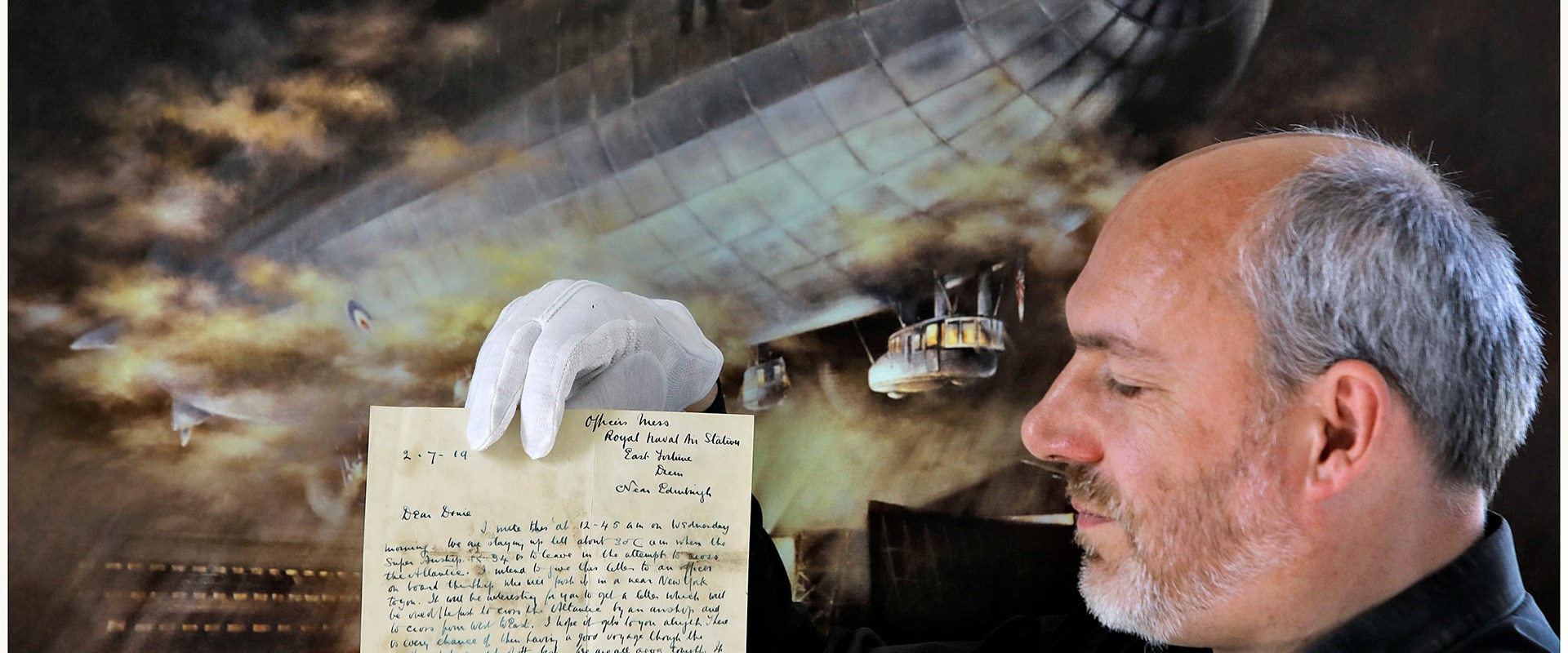Century-old Letter From Record-Breaking Airship Journey Goes on Display at National Museum of Flight
#R34100
A letter written 100 years ago and dropped over Nova Scotia from the R.34 airship during its record-breaking double transatlantic crossing will go on display at the National Museum of Flight in East Lothian on Tuesday 2 July, the centenary of the R.34’s departure from its East Fortune base.
The R.34’s epic journey, which took place just a few weeks after Alcock and Brown’s record-breaking west-east Atlantic flight, was the first ever return flight across the Atlantic and the first east-west crossing by air. The R.34’s trip also involved the first arrival in the USA by air when Major Pritchard parachuted from the airship to take charge of the hundreds of ground crew required, as well as the world’s first human and feline trans-Atlantic aerial stowaways, Newcastle man, William Ballantyne and Wopsie the cat.
The letter, which was recently acquired by National Museums Scotland, was written by the Reverend George Davys Jones who worked as a chaplain at RAF East Fortune. He gave it to the R.34 crew to post to his sister in Bournemouth once the airship had reached the USA. It was dropped from the airship over Nova Scotia on 5 July, discovered by Milton Weldon on 8 November at Selmah, Hants County, forwarded to Halifax, Nova Scotia and then posted back to England where it arrived later that month. The letter describes the sense of excitement about the R.34’s forthcoming journey, explaining that the whole station was required to guide the massive airship out of its shed ahead of its record-breaking flight.
The 634 ft R.34 was stationed at East Fortune, now home to the National Museum of Flight but which started out as a Royal Naval Air Station. Nicknamed ‘Tiny’, her hydrogen-filled gas bags alone required the intestines of 600,000 oxen to make them. The airships came under the command of the Navy as their primary duties were convoy protection and anti-submarine activities. HMA R.34 arrived at East Fortune in May 1919. She had been constructed at the Wm Beardmore factory at Inchinnan near Glasgow but was completed too late to see active service. She had one operational voyage over the Baltic Sea as part of a show of strength in advance of the ratification of the Treaty of Versailles.
Her main claim to fame came in July 1919 when she and her crew of 30 set off on the first direct flight between Britain and the USA. The initial destination was Mineola in Long Island, USA, where rolling grasslands and favourable winds made it a popular choice for aviators including the Wright Brothers. The R.34 reached Mineola at 9.45am on 6 July 1919, 108 hours and 12 minutes after it departed East Fortune, following an adventure-filled journey that was hampered by dwindling fuel supplies, violent squalls and a leak that was repaired with the crew’s entire supply of chewing gum.
The crew was the toast of the town on arrival in the USA and was wined and dined in New York and showered with gifts including a rare case of prohibited rum. The R.34 then flew over the sky scrapers of New York as it set off for home, landing at Pulham in England 75 hours later after inadvertently soaking the welcoming musicians with water ballast.
Sadly, the R34 was scrapped in 1921 following an accident in high winds but her transatlantic journey remains one of Scotland’s most fascinating aerial adventures.
Rev. Jones’ letter will be displayed until 31 October 2019 in the National Museum of Flight’s Fortunes of War gallery, which explains the fascinating history of the Museum’s East Fortune home. It features other objects that help to tell the story of the R.34, including its large bowplate and altimeter dial, binoculars and a camera used on the flight as well as a bottle of brandy taken on board for medicinal reasons. The exhibition also includes a piece of the linen fabric from the airship’s outer cover, part of one of the internal gas-bags and a piece of girder from the airship. Visitors can see a memorial to the flight, a twin of which exists in Mineola, and can recreate the flying experience of the record-breaking giant in an R.34 flight simulator.
This July, the Museum will display additional archive photographs of the R.34 and will conduct a number of 20-minute talks about the epic journey.
Ian Brown, Assistant Curator of Aviation at the National Museum of Flight, said:
“It’s extremely exciting to have Rev. Jones’ letter returned to East Fortune, where it was written exactly 100 years ago, before its own double-crossing of the Atlantic. It’s a fascinating addition to our collections that gives a first-hand account of the excitement felt by everyone on the ground here at East Fortune about this historic flight. The R34’s aerial adventure was front-page news both in the UK and the USA and demonstrated new technology that many believed would be the future of long-distance travel. We hope that as many people as possible will visit during this centenary year to learn more about her record-breaking journey.”
The National Museum of Flight, including the Fortunes of War permanent display, is open seven days a week from 10am until 5pm. Visit www.nms.ac.uk/flight for details and further information.
Note to Editors
- National Museums Scotland looks after museum collections of national and international importance and provides loans, partnerships, research and training in Scotland and internationally. Our individual museums are the National Museum of Scotland, the National Museum of Flight, the National Museum of Rural Life and the National War Museum. The National Museums Collection Centre in Edinburgh houses conservation and research facilities as well as collections not currently on display.
- Bheireadh Oifis nam Meadhanan eadar-theangachadh Gàidhlig den bhrath-naidheachd seachad do bhuidhinn mheadhanan bharantaichte. Cuiribh fios do dh'Oifis nam Meadhanan airson bruidhinn air cinn-latha freagarrach.
For further information and photographs please contact Karen Finlay at Artisan PR, karen@artisanpr.co.uk or call 07803 945043.

